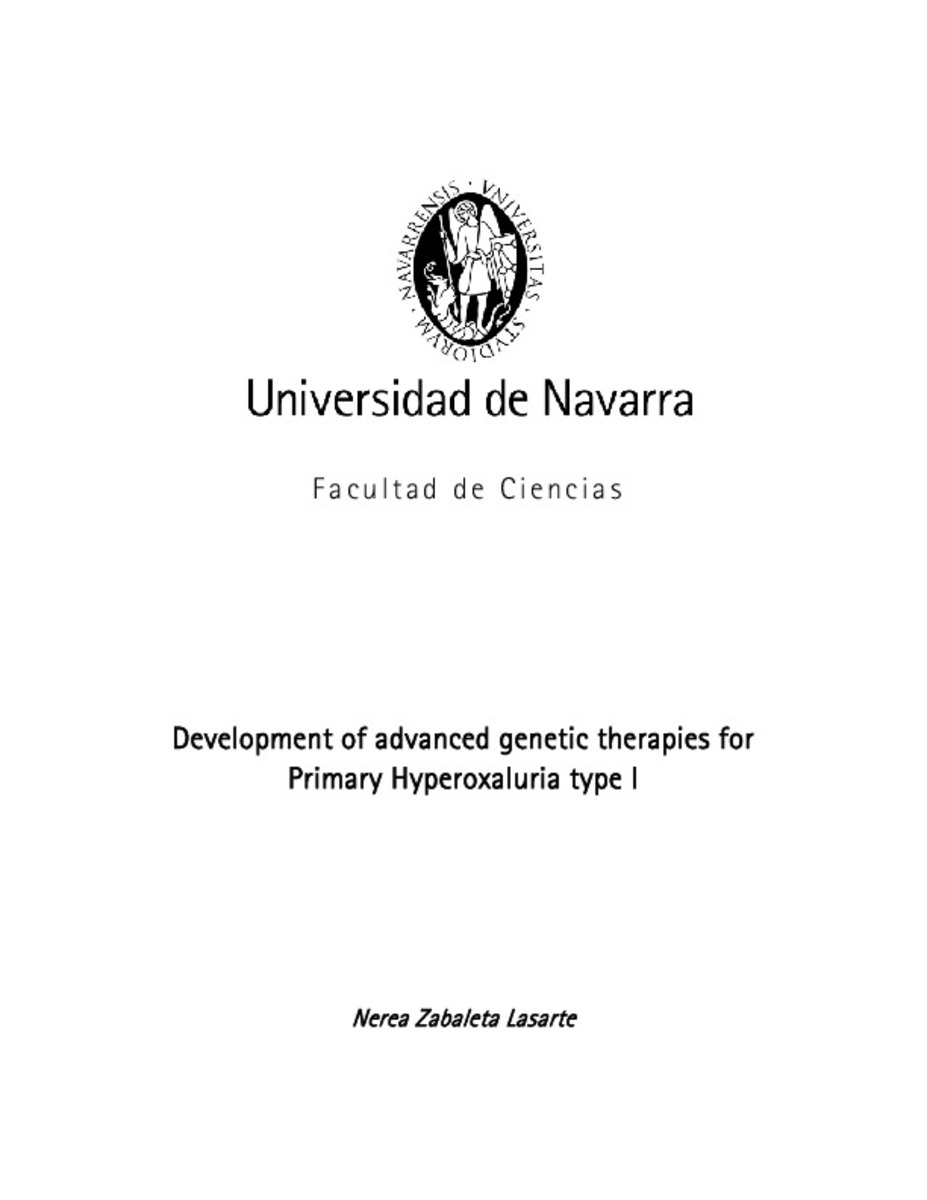Full metadata record
| DC Field | Value | Language |
|---|---|---|
| dc.contributor.advisor | González-Aseguinolaza, G. (Gloria) | - |
| dc.contributor.advisor | Rodriguez-Madoz, J.R. (Juan Roberto) | - |
| dc.creator | Zabaleta-Lasarte, N. (Nerea) | - |
| dc.date.accessioned | 2018-10-30T09:23:16Z | - |
| dc.date.available | 2018-10-30T09:23:16Z | - |
| dc.date.issued | 2018-10-30 | - |
| dc.date.submitted | 2018-02-26 | - |
| dc.identifier.citation | ZABALETA, N. "Development of the advanced genetic therapies for Primary Hyperoxaluria type I", González-Aseguinolaza, G. y Rodríguez, J. R. (dirs). Tesis doctoral. Universidad de Navarra, Pamplona, 2018. | es_ES |
| dc.identifier.uri | https://hdl.handle.net/10171/55467 | - |
| dc.description.abstract | Primary Hyperoxaluria type I (PH1) is an inherited inborn error of the glyoxylate metabolism in the liver. It is caused by mutations in the AGXT gene, a gene that codes the peroxisomal enzyme alanine-glyoxylate aminotransferase (AGT). As a result of AGT deficiency oxalate, which is an end-product of glyoxylate metabolism, is overproduced in the liver. In healthy individuals, oxalate is excreted into urine, but when it is produced at high concentration there is a tendency for calcium oxalate (CaOx) crystals to be generated and deposited in the renal parenchyma, where kidney stones can form. As a consequence, PH1 patients present with severe kidney damage and poor survival of kidneys, developing end-stage renal disease (ESRD) in most of the cases. The only curative treatment is liver transplantation, which is usually combined with kidney transplantation because of the loss of renal function. The main goal of this study was to develop new therapeutic alternatives for PH1 based on advanced genetic treatment. In the initial part of this thesis we tried to improve PH1 gene therapy using adeno-associated viral (AAV) vectors. First, human AGXT was codon optimized in order to improve the expression levels of the protein. In this case, the optimization of the sequence of the AGXT gene resulted in no therapeutic advantage in comparison to the WT version of the gene. Second, we worked on the optimization of AAV gene delivery to the liver in non-human primates (NHP) changing the route of administration. It was demonstrated that the direct administration of AAV vectors into the hepatic blood flow resulted in a higher transduction of the liver in comparison to the systemic intravenous route. In addition, a completely novel approach based on gene editing using the recently discovered clustered regularly interspaced short palindromic repeats/CRISPR associated protein 9 (CRISPR/Cas9) system was designed and characterized. This treatment was focused on a substrate reduction therapy (SRT) strategy, i.e. the reduction of glyoxylate production (the precursor of oxalate). Glycolate oxidase (GO) enzyme is a liver peroxisomal enzyme in charge of the production of glyoxylate. The inhibition of GO synthesis is known to reduce oxalate production. Therefore, a specific CRISPR/Cas9 system was designed to target and disrupt the Hao1 gene (the gene that codes GO) in hepatocytes. Using this strategy we were able to efficiently reduce GO protein levels. Moreover, the treatment resulted in a significant reduction of oxalate production and of renal damage in PH1 mice challenge with oxalate precursors, in absence of toxicity. In conclusion, several strategies to treat PH1 were developed and optimized during this project, which were able to reduce oxalate excretion in the urine of the PH1 mouse model. | es_ES |
| dc.language.iso | eng | es_ES |
| dc.rights | info:eu-repo/semantics/openAccess | * |
| dc.subject | Ingeniería genética | es_ES |
| dc.subject | Metabolismo humano | es_ES |
| dc.subject | Materias Investigacion::Ciencias de la Salud::Genética | es_ES |
| dc.title | Development of the advanced genetic therapies for Primary Hyperoxaluria type I | es_ES |
| dc.type | info:eu-repo/semantics/doctoralThesis | es_ES |
Files in This Item:
Statistics and impact
Items in Dadun are protected by copyright, with all rights reserved, unless otherwise indicated.






